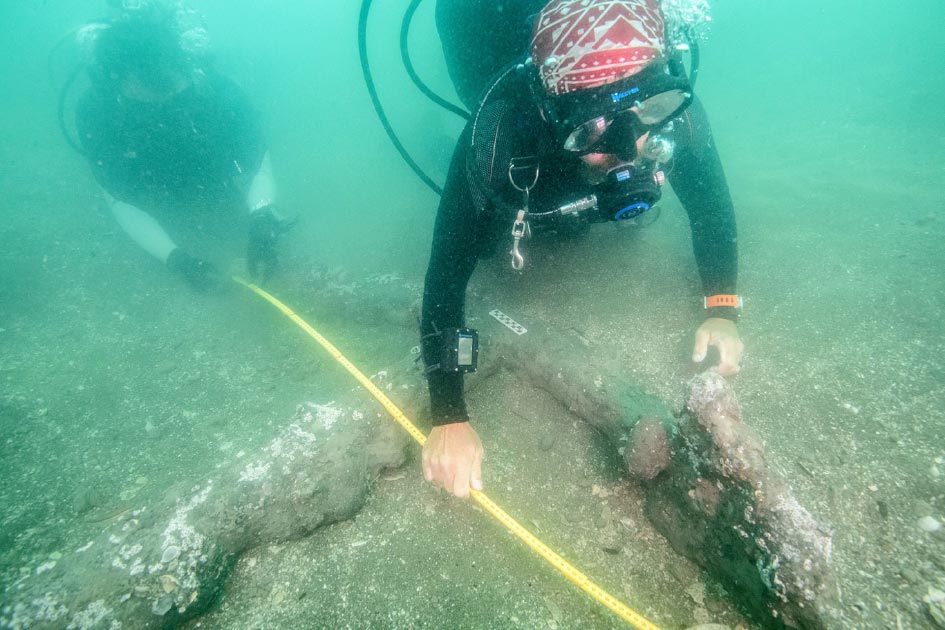Artifacts Thought to be of Spanish Conquistador’s Fleet Found
Marine archaeologists may have found artifacts linked to the Spanish Conquest of Mexico. They have discovered anchors on the seabed in the Gulf of Mexico. These finds are believed to have belonged to ships of the Spanish Conquistadors’ invasion fleet. The anchors were found on the 500 th anniversary of the Cortez invasion of the Aztec Empire.
Divers from Mexico's National Institute of Anthropology and History (INAH) made the finds. There have been previous finds linked to the Cortez invasion fleet made in the area. The divers were searching the seafloor at a spot north of Vera Cruz. They were conducting a magnetometer survey of the seabed and they identified a number of anomalies. Some cord was used to mark two of the anomalies and sand was removed from the areas.
500-year-old anchors
It was then that the divers discovered the two anchors. They were buried at a depth of 33 ft (11m) and 50 ft (16m) and were covered under 3 ft (1m) of sediment. Newsweek reports that ‘Another anchor, featuring an intact wooden crosspiece, was found at the same spot in 2018’. The wood was found to come from Spain and it was carbon-dated to between 1480 1530, which roughly corresponds to the arrival of the Conquistadors in Mexico in 1519.

Anchor found off the Velacruz coast. (Alberto Soto /INAH)
The two anchors found were very similar to one uncovered in 2018, some several hundred feet away. Furthermore, they ‘were found in an orientation—aligned in a southwest direction’ reports Newsweek. This is all evidence that the anchors possibly belonged to vessels that were part of the Cortez fleet.
Burning of Spanish Conquistador’s fleet
We know from historical sources that Cortez had many of his ships burned or sank when he landed, as his men were mutinous. He feared that they would leave the invasion force and return to Cuba. The area where the anchors were uncovered is ‘facing the port of what was Villa Rica’ stated Roberto Junco, in the INAH report. This was a port that was founded by Cortez in 1519, but it was eventually abandoned as Vera Cruz grew in importance. The Spanish are known to have landed here before they set out for the Aztec capital. The location of the anchors and other evidence is apparently confirming the long-held theory that the Spanish Conquistador burned his ships in this part of the Gulf.

Image attributed to Miguel Gonzalez of Hernan Cortes scuttling his fleet off the Veracruz coast. On display at the Naval History Museum in Mexico City. (CC BY-SA 4.0)
However, the marine archaeologists are reluctant to definitively state that the anchors were part of the Cortez invasion fleet. The port of Villa Rica was very busy in the aftermath of the fall of the Aztec Empire. Furthermore, according to the documentary sources, another Spanish fleet was in the Gulf shortly after Cortez.
The downfall of the Aztec Empire
After burning most of his fleet, the Spaniard overthrew the mighty Aztec Empire by allying with natives. Aztecs policies such as the human sacrifice of captives had made them so unpopular that they joined with the Europeans. This allowed the Spanish to overthrow the last great Mesoamerican empire in only two years.
The arrival of the Spanish was one of the most important events in global history and this is what makes finding the anchors so important. One of the marine archaeologists who took part in the expedition, Frederick Hanselmann, stated that they are symbols “of the cultural collision that led to what is now the West, geopolitical and socially speaking” reports Travel + Leisure. The Conquest of Mexico is still very controversial. “Mexico's President Andres Manuel Lopez Obrador asked Spain to apologize to indigenous Mexicans for abuses committed during the invasion” according to the BBC.
The marine archaeologists are continuing their work at the site. They are investigating other anomalies on the seafloor. The BBC reports that “A further 15 potential sites containing anchors have been identified”. It is hoped that they will find more anchors and artifacts that will conclusively prove that Cortez had his ships sunk in this area.
Top image: Anchor believed to belong to a ship of the Spanish Conquistadors. Source: INAH
By Ed Whelan



















